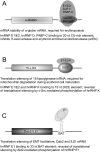Heterogeneous nuclear ribonucleoproteins (hnRNPs) in cellular processes: Focus on hnRNP E1's multifunctional regulatory roles
- PMID: 20584894
- PMCID: PMC2905745
- DOI: 10.1261/rna.2254110
Heterogeneous nuclear ribonucleoproteins (hnRNPs) in cellular processes: Focus on hnRNP E1's multifunctional regulatory roles
Abstract
Heterogeneous nuclear ribonucleoproteins (hnRNPs) comprise a family of RNA-binding proteins. The complexity and diversity associated with the hnRNPs render them multifunctional, involved not only in processing heterogeneous nuclear RNAs (hnRNAs) into mature mRNAs, but also acting as trans-factors in regulating gene expression. Heterogeneous nuclear ribonucleoprotein E1 (hnRNP E1), a subgroup of hnRNPs, is a KH-triple repeat containing RNA-binding protein. It is encoded by an intronless gene arising from hnRNP E2 through a retrotransposition event. hnRNP E1 is ubiquitously expressed and functions in regulating major steps of gene expression, including pre-mRNA processing, mRNA stability, and translation. Given its wide-ranging functions in the nucleus and cytoplasm and interaction with multiple proteins, we propose a post-transcriptional regulon model that explains hnRNP E1's widespread functional diversity.
Figures



References
-
- Akker SA, Misra S, Aslam S, Morgan EL, Smith PJ, Khoo B, Chew SL 2007. Pre-spliceosomal binding of U1 small nuclear ribonucleoprotein (RNP) and heterogenous nuclear RNP E1 is associated with suppression of a growth hormone receptor pseudoexon. Mol Endocrinol 21: 2529–2540 - PubMed
-
- Anderson P 2010. Post-transcriptional regulons coordinate the initiation and resolution of inflammation. Nat Rev Immunol 10: 24–35 - PubMed
-
- Baharvand H, Fathi A, Gourabi H, Mollamohammadi S, Salekdeh GH 2008. Identification of mouse embryonic stem cell-associated proteins. J Proteome Res 7: 412–423 - PubMed
Publication types
MeSH terms
Substances
Grants and funding
LinkOut - more resources
Full Text Sources
Other Literature Sources
